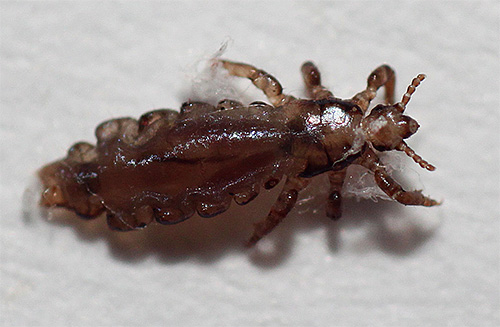
Such a type of parasite as bed lice, in nature, strictly speaking, does not exist. This is what the people usually call the head louse or the clothes (linen) louse, which is accidentally found on the bed. These insects are blood-sucking parasites belonging to the same species, but to its different forms.
The head louse constantly lives on the head, and the body louse lives on the clothes of a person. On the bed, both parasites are completely accidental and cannot exist here for a long time. However, it was rare chance encounters that gave rise to people calling the bed louse.
On a note
Human lice cannot starve for more than a day, and their larvae - more than a few hours. Accordingly, a louse that has fallen on the bed is practically a doomed suicide bomber, since it still needs to live until the next visit of a person to the bed. And if the body louse solves this problem, settling on the clothes of those people who never change clothes (tramps and various declassed elements), then the head louse could not solve this problem. That is why the head louse is only occasionally found in the cheapest hotels and hostels, where it falls accidentally from the heads of infected guests.
Bed lice: what do they look like?
The bed louse is a small insect with a body length of 0.5 to 3 mm, depending on age and stage of development. The parasite has no wings and moves only by crawling. Moreover, its paws are poorly adapted for walking or moving on a flat surface: each leg of a louse carries a rounded claw, thanks to which the insect can stay on a tuft of hair (see photo):
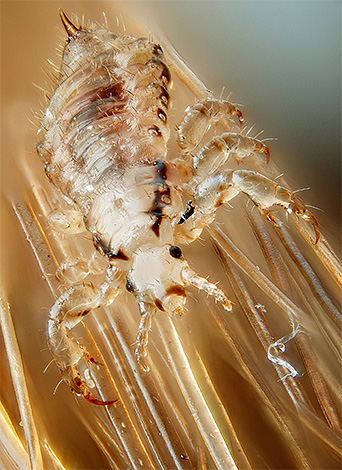
It is here, on the hair of the human body or the fibers of woolen clothes, that lice spend most of their time. They crawl to the surface of the body every few hours in order to pierce the skin and drink blood.
It is interesting
The clothes (linen) louse, which spends most of its time on clothes, has noticeably changed its morphology over many centuries of evolution and has adapted to clinging to fabrics and skin. However, when body lice move to their heads, they get used to the original living conditions in several generations.
Bed lice look unattractive. They have an elongated abdomen and a small head. Their body color is light gray, almost white, but after feeding, when the abdomen is filled with blood, the louse becomes red or brown.
In the photo below - bed lice at the site of bites:
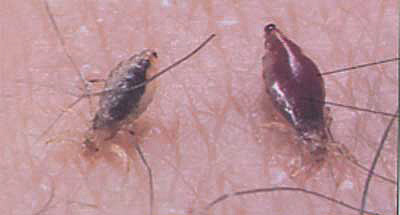
The following photo shows what bed lice look like under a microscope:
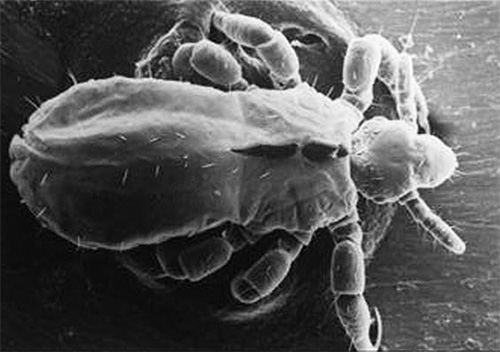
It is interesting
The pubic louse has a body shape that is different from that of the bed louse. Its abdomen is much shorter, and its legs are more powerful. On the bed, pubic louse is almost never found. A photo of a pubic louse is shown below:
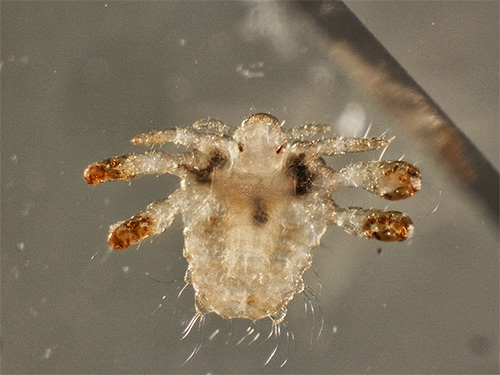
The main signs of bed lice to distinguish them from other parasites:
- small sizes
- transparent body coverings
- immobility
- elongated abdomen.
Bed lice larvae are very similar to adult insects and outwardly differ from them only in size. They also feed on blood and live with adult insects. Before becoming an adult louse, the larva needs to molt three times.
Bed lice bite a person at any time, the main thing is that the human body itself is nearby. Below is a photo of bed lice bites - they are very similar to those of bed bugs, but differ in that the lice never leave a chain of several bites:
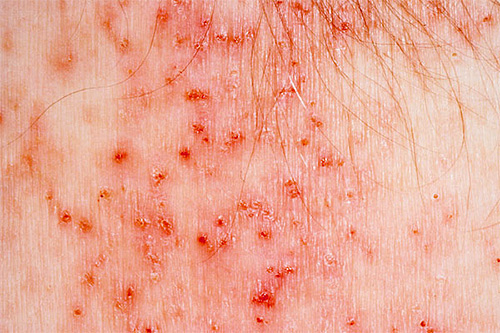
Bed lice eggs attach themselves to the folds of a person's clothing and, in exceptional cases, to the bed itself, on which people often and regularly sleep. Encased in a special capsule to attach to the hair, such an egg is called a nit. On the bed and clothes it is incredibly difficult to find because of its white color and tiny size.
The photo shows a bed louse and its egg on the finger.
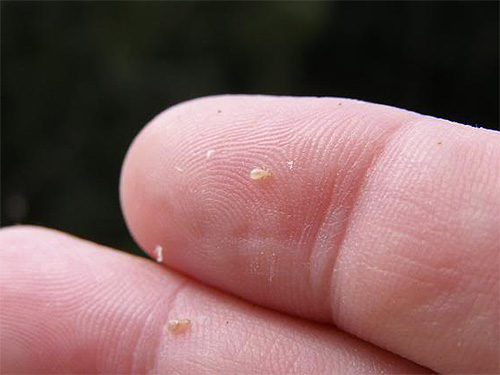
On a note
Bed lice and their bites are often confused with other parasites. For example, a well-fed bed louse looks like a flea, except that it cannot jump. But even more often, lice are called small larvae of bedbugs, also translucent with a drop of blood in the abdomen. It is bedbugs that are much more likely to be found in bed - this is their usual habitat, in contrast to lice, which are found only occasionally on the bed. And if “lice in the bed” were already found - under the mattress or on the body - these are guaranteed bugs. The lice simply wouldn't crawl there.
Lice on the bed: what are they doing here?
Lice are ectoparasites that constantly live on the human body, that is, parasites that do not penetrate the body. In their attachment to the human body, they differ from other parasites: fleas, ticks, bedbugs live and breed in apartments and nature, but they climb on a person only to feed. In lice, the entire reproduction cycle occurs on the hair and human body.
The main purpose of the presence of lice on the human body is nutrition. Their only food is blood, for which they bite, piercing the skin with their thin stylet-like jaws, and suck several micrograms of blood per feeding. Despite their miniature size, bed lice bites are more painful than, for example, mosquito bites, and look like small bumps with a hole in the center.
In the photo below - bed lice bites on the body. Such lesions are characteristic of cases where there are a lot of lice.
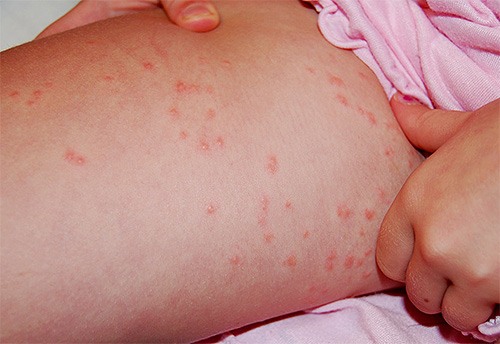
On the bed, lice are extremely rare and only as an exception. Only individuals that accidentally fall from the body or head turn out to be here, and there are no permanent populations that breed in bed.
However, if a person lies on the bed on which the louse has fallen, the parasite will move onto his body and begin his usual way of life again.
There are no massive lice on the bed, and even several individuals in one bed can appear only if a heavily infected person spent the night on it.
If you find a lot of "lice" in the bed, then most likely these are bed bug larvae.
Why are bed lice dangerous?
Individual bites of bed lice are not the biggest nuisance.They become especially dangerous in large quantities, when massive bites cause pediculosis in humans - a set of symptoms similar to a skin disease. Pediculosis is usually accompanied by:
- rash on the body
- the appearance of pustules and scars
- bluish pigment spots
- roughening of the skin.
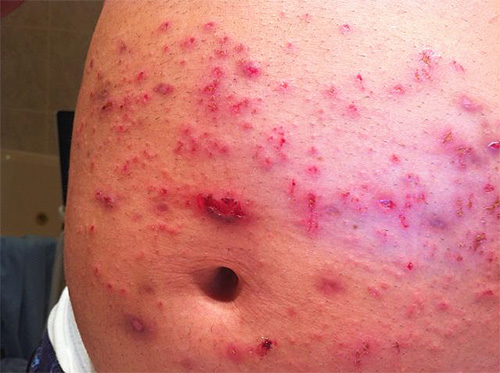
In especially advanced cases, with pediculosis, ulcers and boils appear, pyoderma can develop with symptoms of any severity.
But lice are even more dangerous because they carry pathogens of several deadly diseases, among which typhus and relapsing fever are the most famous. Today, these diseases are found mainly in developing countries, but they have not lost their danger at all.
And further: A very useful thing that allows you to get rid of lice and nits without any chemicals - a special medical comb ...
But in general, lice always spoil the quality of human life. Constant itching from bites, messy hair with nits, skin lesions do not allow a person to feel normal and repel others from him. Therefore, in case of a possible infection with parasites, you should always know how to remove bed lice.
Ways to get rid of bed lice
To combat bed lice on hairy parts of the body, special shampoos, aerosols or lice lotions such as Nittifor, Nit Free, Para-plus are usually used. They process hair and infected areas of the body, if possible - wrap themselves in polyethylene for several hours, and then wash them.

Previously, kerosene and vinegar were used for the same purposes, but modern products are much more effective and less aggressive towards human skin.
You can also get rid of bed lice on your head with the help of special antiparasitic combs. However, it should be remembered that such devices require spending several days to get rid of lice - by periodically combing them out of the hair.

On a note
Simple combs, even thick ones, will not comb out lice and nits. Antiparasitic instruments have a tooth spacing approximately equal to the thickness of a few hairs, as well as hard, rigid teeth. This allows them to catch even nits, which conventional combs cannot handle.
It is necessary to specially treat the bed from lice in a washing machine at maximum temperature. Already at 55 ° C, lice die within half an hour, and with the addition of an insecticidal shampoo, even faster.
In most cases, treatment of the bed from lice is not required - it is enough to remove it and simply take it outside for a day. Insects will die of starvation during this time. After that, the bed is easy enough to wash.
It is very important to treat the bed after lice on the same day that the parasites are fought by the residents of the apartment themselves. This will reduce the risk of possible secondary infection.
But instead of learning how to get rid of bed lice, it is much more rational to apply preventive measures and protection against infection with them.
Prevention of head lice in the house
Lice get into any room or bed only with an infected person. They cannot crawl themselves or arrive on a set of bed linen.

Cases of lice getting into the room with the furniture itself are practically excluded - during the time that the sofa or bed is being transported, the lice will simply die of hunger. Therefore, the best ways to prevent lice from entering the house will be:
- Avoiding visits from people or children living in questionable sanitary conditions.
- Checking the friends of the children who come to the house. Usually, with a serious infection, nits on the head of a child are visible to the naked eye.
- Mandatory quarantine after visiting cheap hotels, hostels, hostels - if you suspect a lice infestation, it is advisable to wash your hair with an insecticidal shampoo for several days and monitor the condition of your scalp.
You should always remember that protecting your home and bed from lice begins with protecting yourself. Therefore, it would be best to exclude your own contacts with dubious characters, casual sex and communication with dysfunctional teenagers. So with a high probability of infestation with lice can be avoided.
What is useful to know about lice for any person
Getting rid of lice with a comb - instructions

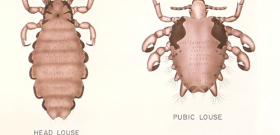

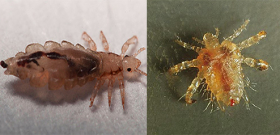
Thanks for the good advice, but maybe a scratch on your head, but you didn’t find any lice? Chess on the body - and also did not find it. How to be?
An effective way to deal with these parasites is regular lemon juice. Eat lemons, garlic, onions, salt, pepper, mustard. They are absorbed into the blood, and lice bite less. Lemon can be rubbed, very effectively. You can make perfumes from lemon juice, various perfumes, soaps, shampoos, based on citrus fruits. Secondly, ordinary cellophane - it does not let air through, and they suffocate. You can make a bed, and cover it with a clean sheet, or a silk bedspread. You can sprinkle salt on the bed, moisten with salt water, baking soda, for washing. When working with chemicals, be careful, wear rubber gloves, take a hot shower, wash yourself properly. Keep clothes in plastic bags, ordinary blue 60 liters, for garbage. And rub with lemon. Washing, ironing, a regular washing vacuum cleaner, a steam mop, an iron, bags are very effective. I wish everyone good health, Oleg Ivanovich was with you!
Thanks for the practical advice. Please advise something else.
Oleg, thank you very much! There is a lot of rubbish on the Internet, and zero effective ways. Good ways!
Sorry, but figs they are suffocating. Checked. By the way, I can even guess why. Do you think we have oxygen in our blood? They dig into us and breathe. It's funny - but it's their straw. We kept bags with our daughter for days, tea tree oil, eucalyptus, lavender, olive oil, all in a mixture, under the bags. DAY! Under two layers of bags. Air out! They took it off, washed it off, looked at it - and they, bitches, are LIVE! So it's all nonsense. We also fell for the record of the bags and oils and the lack of oxygen. Maybe my review will help others avoid such mistakes.
And even after treating the hair, it is good to warm the hair roots with a hairdryer at the maximum temperature, for as long as you can withstand. Without fanaticism, of course, it is not necessary to burn the skin.